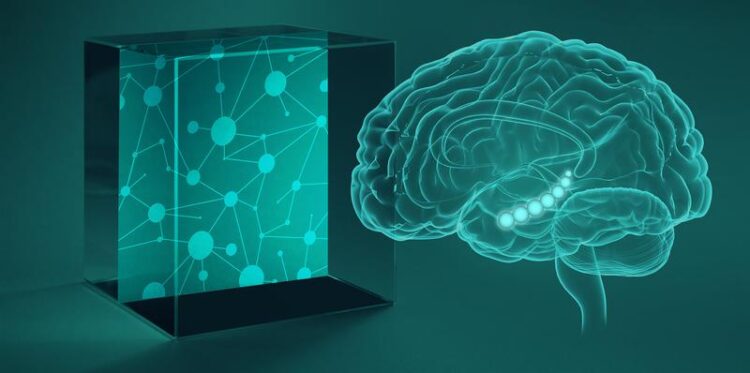Mapping knowledge – how the brain’s navigation system extracts meaning

The hippocampus contributes to concept learning, by representing behaviorally-relevant information in low-dimensional spaces.
MPI CBS
How is conceptual knowledge represented in the brain such that we can flexibly use it to interpret unfamiliar information or to infer relations we’ve never directly experienced? One means of organizing conceptual knowledge would be in a kind of internal map. Thus, the map would have to be dynamically defined along those feature dimensions that are currently relevant to the concept.
Stephanie Theves and Christian Doeller of MPI CBS in Leipzig together with Guillén Fernández of the Donders Institute Nijmegen, have now shown such a distinction between conceptually relevant and overall features for the mapping function of the hippocampus.
How is conceptual knowledge represented in the brain such that we can flexibly use it to interpret unfamiliar information or to infer relations we’ve never directly experienced? One means of organizing conceptual knowledge would be in a kind of internal map: For example, one might infer whether an unknown animal can fly based on its proximity to familiar animals in a space defined along the feature dimensions ‘body weight’ and ‘wing size’.
However, a given animal exhibits many more features than just those relevant to its ability to fly. Thus, in order to use a map-like representation to transfer meaning (e.g. able to fly?) to novel information (e.g. an unknown animal) via similarity to familiar exemplars, the map would have to be dynamically defined along those feature dimensions that are currently relevant to the concept.
Stephanie Theves and Christian Doeller of MPI CBS in Leipzig together with Guillén Fernández of the Donders Institute Nijmegen, have now shown such a distinction between conceptually relevant and overall features for the mapping function of the hippocampus.
The group has led the way in showing that the hippocampal formation, originally considered the brain’s navigational system, encodes far more than just mental maps of our spatial environment. It can also organize more abstract, non-spatial information into map-like representations.
In the present study, participants learned to classify novel abstract objects (which varied in terms of the frequency of their stripes, dots, and opacity) into two categories, based on the ratio of only two of their three features. These two feature dimensions could be regarded like the x- and y-axis of a coordinate system, in which the diagonal reflects the category boundary.
For instance, an object with relatively high opacity as compared to its dot frequency would belong into category B. Its stripe frequency was irrelevant here. Importantly, while only two of the objects’ three feature dimensions thus defined the concept of the two categories, all three object features had to be precisely memorized.
“The design of the study allowed us to investigate whether the hippocampus indeed forms a map-like representation of the concept in specific” explains lead author Stephanie Theves. Using brain activity patterns of the hippocampus, measured with functional MRI, along with sophisticated statistical analyses the team was able to confirm their hypothesis.
Theves concludes “Our analyses indicate that the hippocampus integrates only those feature dimensions that are relevant in relation to each other, to define the concept in a map-like representation. In other words, even though specific exemplars were encoded and remembered on all dimensions, a conceptual representation seemed to be carved out from the totality of the features. Therefore, we assume that the hippocampus contributes to concept learning, by representing behaviorally-relevant information in low-dimensional spaces.”
Wissenschaftliche Ansprechpartner:
Stephanie Theves
Postdoc
theves@cbs.mpg.de
Originalpublikation:
The Hippocampus Maps Concept Space, Not Feature Space
Stephanie Theves, Guillén Fernández and Christian F. Doeller
Journal of Neuroscience 16 September 2020, 40 (38) 7318-7325;
DOI: https://doi.org/10.1523/JNEUROSCI.0494-20.2020
Weitere Informationen:
Media Contact
All latest news from the category: Life Sciences and Chemistry
Articles and reports from the Life Sciences and chemistry area deal with applied and basic research into modern biology, chemistry and human medicine.
Valuable information can be found on a range of life sciences fields including bacteriology, biochemistry, bionics, bioinformatics, biophysics, biotechnology, genetics, geobotany, human biology, marine biology, microbiology, molecular biology, cellular biology, zoology, bioinorganic chemistry, microchemistry and environmental chemistry.
Newest articles

Recovering phosphorus from sewage sludge ash
Chemical and heat treatment of sewage sludge can recover phosphorus in a process that could help address the problem of diminishing supplies of phosphorus ores. Valuable supplies of phosphorus could…

Efficient, sustainable and cost-effective hybrid energy storage system for modern power grids
EU project HyFlow: Over three years of research, the consortium of the EU project HyFlow has successfully developed a highly efficient, sustainable, and cost-effective hybrid energy storage system (HESS) that…

After 25 years, researchers uncover genetic cause of rare neurological disease
Some families call it a trial of faith. Others just call it a curse. The progressive neurological disease known as spinocerebellar ataxia 4 (SCA4) is a rare condition, but its…





















